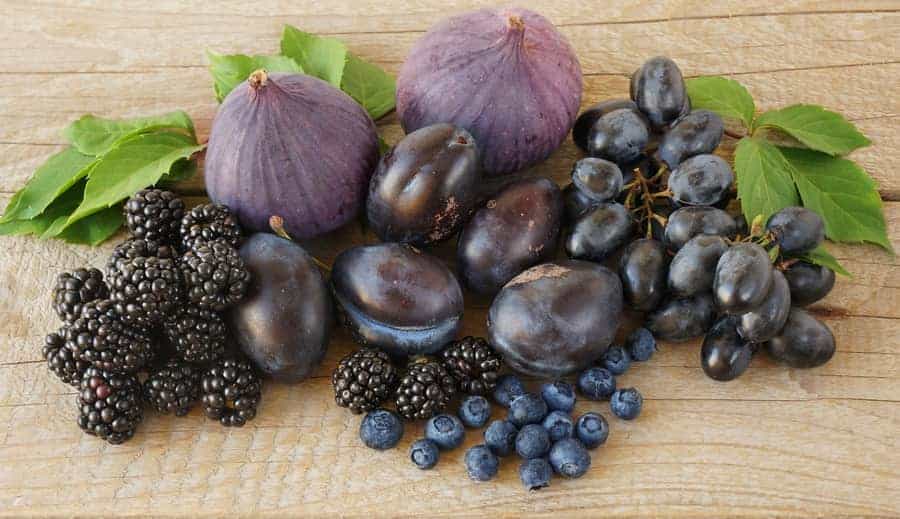
Phytonutrients are the 100,000+ chemicals in plants that ward off disease, pests, radiation from the sun, and other hazards. Many phytonutrients are antioxidants, and in people have anti-cancer, anti-inflammatory and anti-aging effects, among other benefits.
Phytonutrients are often pigments, and the blue/purple phytonutrients are typically anthocyanins and proanthocyanidins. They are responsible for the color of many blue and purple fruits and vegetables. Here’s a chart that shows which blue/purple phytonutrients are in which foods, and what their associated benefits are:
| Red-pigmented Phytonutrient | Foods With Highest Levels | Associated Benefits |
| Anthocyanins* | Blueberries, blackberries, elderberries, purple grapes, raisins, eggplant, plums, figs, prunes, purple potatoes | Support healthy blood pressure, reduce risk of heart disease, improve memory, and lower risk of cancer. |
| Proanthocyanidins | Blueberries, black currant, cranberries, purple grapes, acai. | Support the venous system; reduce blood pressure; help prevent UTIs. |
*Anthocyanins appear red in acidic conditions and blue in alkaline solution.
These two phytonutrient families, while similar in color, come from different places in the phytonutrient family tree; which means they have different chemical structures.
Anthocyanins are a flavonoid, as are flavonols, flavones, flavanones, flavanols and isoflavones.
Proanthocyanidins are flavanols, which are also part of the flavonoid group, as described above.
As you can see, these two phytonutrients are found in many of the same fruits and vegetables, so you can get them both in the same serving of food.
Not all plants that contain these blue/purple-pigmented phytonutrients are red. For example, cocoa and some teas also contain these phytonutrients, but don’t appear blue or purple. Eating by color is a good guideline, but it isn’t the only way to get each phytonutrient. As always, eating a wide variety of fruits and vegetables is best.
Get a complete list of antioxidants in my article here.
Tips for getting more fruits and vegetables into your diet
The most recent US Dietary Guidelines recommend 2 1/2 cups of vegetables and 2 cups of fruit each day, based on a 2,000-calorie diet. That’s 8 1/2 servings of fruits and vegetables every day. Here are some ways to max up your nutrition with minimal effort:
- Remember that a serving isn’t very big. One serving is one small piece of fruit like an apple, banana or orange. It is also 1/2 cup chopped fruit or veggie, or 1 cup of leafy greens. You can do this!
- Choose “super foods” with multiple benefits. For example, blueberries and strawberries contain multiple phytonutrients, vitamins and minerals.
- As soon as you bring fresh produce home from the store, wash and cut it (if necessary). Put the prepped fruit and veggies in see-through glass containers in your fridge. They will look pretty and be easy to grab every time you open the fridge door.
- Every day, make one meal, or part of one meal, a salad. Put as many fruit and veggie varieties as you can into your salad so you’re getting multiple servings in one dish.
- Remember the number 2: have 2 servings at each meal, and then you will only need 1 1/2 more serving at snack time to get your daily allotment. Don’t save up all your servings for dinner.
Tips for getting BLUE/PURPLE fruits and vegetables into your diet
- Sprinkle blueberries or blackberries (or both) on your cereal or oatmeal every morning, or have them on the side of whatever you are having. Or include them in your smoothie. Breakfast = berries (remember: b=b).
- When choosing between red and green grapes, choose red. When choosing between red and white onion, choose red. When choosing between red and white wine…..you get the idea. In general, the more richly-colored the food, the richer in phytonutrients it is.
- Make pasta or rice dishes with eggplant, and leave the peel on to get the nutrients from the dark purple skin (choose organic if possible and wash well)!
Hope this answers your questions about red phytonutrients.
Read about the yellow/orange phytonutrients here.
Read about the red phytonutrients here.
Read about when it’s safe—or not—to eat the skin on fresh produce here.
Resources
- Khoo, H. E., Azlan, A., Tang, S. T., & Lim, S. M. (2017). Anthocyanidins and anthocyanins: colored pigments as food, pharmaceutical ingredients, and the potential health benefits. Food & nutrition research, 61(1), 1361779. https://doi.org/10.1080/16546628.2017.1361779.
- https://uwyoextension.org/uwnutrition/newsletters/nutrition-rainbow-of-pigment-power/.
- Blesso C. N. (2019). Dietary Anthocyanins and Human Health. Nutrients, 11(9), 2107. https://doi.org/10.3390/nu11092107.
- Abdur Rauf, Muhammad Imran, Tareq Abu-Izneid, Iahtisham-Ul-Haq, Seema Patel, Xiandao Pan, Saima Naz, Ana Sanches Silva, Farhan Saeed, Hafiz Ansar Rasul Suleria, Proanthocyanidins: A comprehensive review, Biomedicine & Pharmacotherapy, Volume 116, 2019, 108999, ISSN 0753-3322. https://doi.org/10.1016/j.biopha.2019.108999.
- Wilhelmina Kalt, Aedin Cassidy, Luke R Howard, Robert Krikorian, April J Stull, Francois Tremblay, Raul Zamora-Ros, Recent Research on the Health Benefits of Blueberries and Their Anthocyanins, Advances in Nutrition, Volume 11, Issue 2, March 2020, Pages 224–236, https://doi.org/10.1093/advances/nmz065.
- Yang, L., Xian, D., Xiong, X., Lai, R., Song, J., & Zhong, J. (2018). Proanthocyanidins against Oxidative Stress: From Molecular Mechanisms to Clinical Applications. BioMed research international, 2018, 8584136. https://doi.org/10.1155/2018/8584136.
- US Dietary Guidelines.
